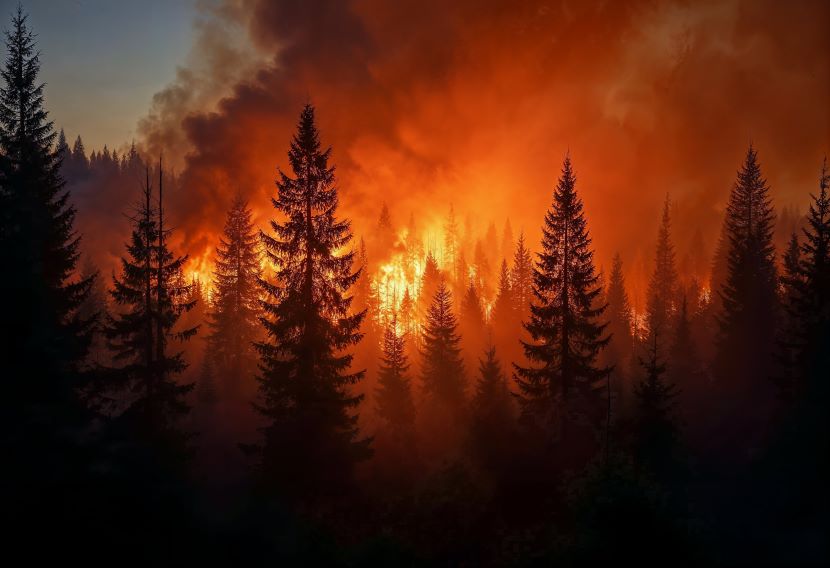Published on
August 13, 2025
Travellers in Spain are facing significant disruptions this week due to a series of wildfires sweeping across multiple regions. The fires, which are being fueled by high temperatures and strong winds, have led to widespread cancellations, detours, and delays, particularly affecting train travel. Galicia, in the northwest of Spain, is experiencing the worst impacts, with several major rail routes being cut off.
The most severe impact of the wildfires is in the region of Galicia, particularly near the town of Ourense. A large blaze in the Barreiros Industrial Estate has forced the cancellation of high-speed train services between Madrid and Galicia, as well as between Santiago de Compostela and Ourense. The fire, which continues to burn in a forested area near Seixalbo, has spread dangerously close to a local soccer field, leading to heightened concerns from local authorities.
Renfe, Spain’s national rail operator, confirmed that the fire has severed communication between Ourense and Taboadela, affecting the AVE high-speed trains on critical northern routes. As a temporary measure, special shuttle services have been introduced between Madrid and Zamora, with stops in Segovia and Medina AV. Passengers traveling between A Gudiña and Ourense are being transported by bus. Despite these adjustments, travellers have reported being stranded at the Santiago de Compostela station, with few alternative means of transportation available.
Emergency Response and Government Action
The Galician regional government has declared a provincial emergency level 2 for Ourense, where nine of the twelve large wildfires in Galicia are currently burning. These include the devastating Requeixo fire in Chandrexa de Queixa, which has destroyed 3,000 hectares of land, and the Santiso fire in Maceda, which threatens nearby villages. Smaller fires are also burning in A Mezquita and Cartelle.
Elsewhere in Spain, wildfires have also forced evacuations near León, Tarifa, and Tres Cantos in Madrid. In León, the fire has caused damage to parts of Las Médulas, a UNESCO World Heritage site famous for its dramatic red cliffs and ancient Roman gold mines. Around 800 residents have been evacuated or confined to their homes due to the spreading flames.
According to Spain’s Ministry for the Ecological Transition (MITECO), by August 3, more than 39,000 hectares had already burned across the country, surpassing last year’s totals. This number is expected to rise as additional fires continue to ravage tourist-heavy regions.
Impact on Spain’s Tourism
The fires have had a significant impact on tourism, especially in regions that are popular with travellers. The northwest and Mediterranean regions have borne the brunt of the damage, with wooded areas, scrubland, and pastures being heavily affected. The high temperatures and dense summer vegetation have made the fires more severe, and human negligence or deliberate ignition may have played a role in sparking some of these blazes.
Tourists planning to visit Galicia or other affected areas are being advised to stay informed through official channels such as Renfe, the Ministry of the Interior, and regional emergency services. Given the dynamic nature of the situation, flexible travel arrangements are essential, as transport routes can change with little notice, and road options are often limited.
Key Points for TravellersTrain Cancellations: High-speed rail services between Madrid, Santiago de Compostela, and Ourense have been cut off, with temporary shuttle services in place.Bus Transport: Bus services are available for some routes, such as those between A Gudiña and Ourense.Evacuations: Wildfires have forced evacuations in several regions, including León, and part of the UNESCO World Heritage site of Las Médulas has been damaged.Tourism Disruptions: While Galicia’s coastal cities like A Coruña remain open to visitors, travellers heading inland should expect significant delays and cancellations.Safety Precautions: It is crucial for tourists to prioritize safety and monitor local updates when visiting affected regions. Flexible itineraries are advised.Heat and Hydration: Travellers should be prepared for extreme heat and stay hydrated, especially if planning to visit rural or forested areas.What to Do If Traveling in Affected Areas
For those already in the affected regions, adjusting travel plans to avoid high-risk provinces is crucial. Safety should always be the primary concern, with an emphasis on avoiding areas directly impacted by the fires. While Galicia’s coastal areas and cities like A Coruña remain operational, inland destinations such as Ourense and Santiago de Compostela are experiencing major disruptions.
Tourists should follow the guidance of local authorities and be prepared to adjust their travel plans as needed. It’s essential to remain flexible, as transport routes can be altered at short notice. Additionally, tourists should avoid non-essential travel to forested or rural areas, where the risk of wildfires is highest.
Preparing for Spain’s Wildfire Season
Wildfire season in Spain typically peaks in July and August, but climate conditions are causing these fires to occur earlier and last longer than usual. This year, the wildfires have been particularly severe due to a combination of hot temperatures, strong winds, and limited fire prevention measures.
For tourists visiting Spain during these months, packing appropriately for extreme heat is essential. Staying hydrated and following local advice will help minimize health risks. In addition, tourists should remain vigilant and stay informed about potential changes to their travel plans.
Conclusion: Navigate Travel Disruptions in Spain’s Wildfire Zones
Despite the challenges posed by the wildfires, much of Spain’s tourism infrastructure remains open. Coastal cities, major tourist attractions, and cultural destinations continue to welcome visitors, although inland travel may be hindered by delays or cancellations. Those planning trips to northern Spain, particularly Galicia, should prepare for potential disruptions and prioritize safety. By staying informed and flexible, tourists can still enjoy a safe and rewarding visit to Spain while navigating the challenges posed by these fires.
For ongoing updates, travellers are encouraged to monitor official sources such as Renfe, the Ministry of the Interior, and regional emergency services.
